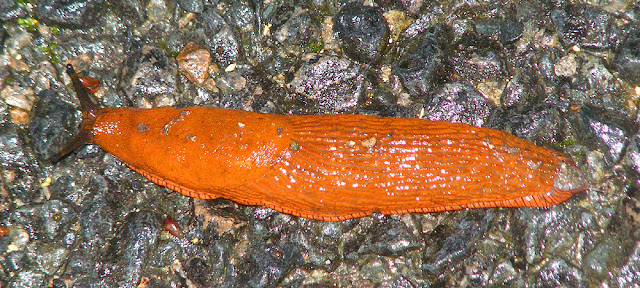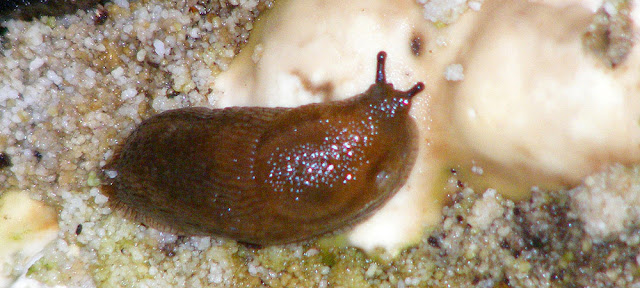It's been quite wet and autumnal throughout late September and early October, so the mollusc population of the Loire Valley has been out and about. We get some gigantic specimens of slugs and snails here so I've been photographing them as I come across them and will now present them to you.
The slugs are all from the Forest of Loches, the snail lives with his mates in a woodland clearing on a Buddhist retreat. All of the adults were at least 10 cm long.
 |
| Red Slug Arion rufus (Fr. Grande loche). |
Confusingly, Red Slugs aren't always red. They can be brown or black. Because I found it in the Forest of Loches I can be reasonably confident that it is A. rufus and not one of the other species that look identical, but it is quite a complicated species complex that includes several species and subspecies, some of which can hybridise. A. rufus is the species that is native to here, but one of the southern species has invaded and is taking its place in some parts of France. They eat decaying matter of all sorts, as well as living plants, fungi and faeces.
 |
| Juvenile Red Slug. |
 |
| Ash-black Slug Limax cinereoniger (Fr. Grande limace). |
Ash-black Slugs are one of the keeled slugs (that's the grey line down the middle of the back) and the largest slug in the world. It is native to woodland habitats in northern and central Europe but doesn't occur in the south. It can be black like this one or grey with black stripes. It eats algae and mushrooms, and is seen here enjoying a bracket fungi feast.
 |
| Roman Snail Helix pomatia (Fr. Escargot de Bourgogne). |
Roman snails are known as Burgundian snails in France (Escargot de Bourgogne), and are the famous edible snail you see on menus. This one perfectly illustrates why one of their nicknames is the gros blanc ('large white'). They aren't all as pale as this, but population at La Gendronnière, where this one was photographed do all seem to be. They are perfectly safe at La Gendronnière, as it is a Buddhist retreat.
The species is rare and protected in France, and not commercially viable to farm, so the ones you get in French restaurants have been gathered in the wild in Eastern Europe. The reason they are known in France as Burgundian snails is because they are traditionally prepared in the Burgundian style of cuisine, as well as Burgundy being part of their natural distribution area. They never range further than 6 metres from where they were hatched, and are normally found in grassy locations on calcareous soil.

1 comment:
In California there is a banana slug in the coastal forests, yellow as you might guess, and about 3-4" long. If you hold it on your hand you can feel its tongue scraping along to see if you are edible. Quite a gorgeous mollusc.
bonnie in the vaucluse
Post a Comment